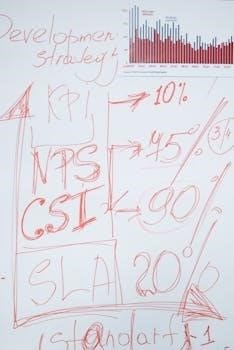Printable Numbers 1-10 PDF⁚ An Overview
Printable number 1-10 PDFs are a fantastic resource for early childhood education. These digital worksheets offer a fun, accessible way to learn basic numeracy skills. They often include number tracing, counting exercises, and matching games.
Printable number resources offer a convenient and engaging way to introduce young learners to the world of mathematics. These resources typically include worksheets and activities designed to help children recognize, trace, and count numbers from 1 to 10. They cater to diverse learning styles. Free printable number worksheets provide ample opportunities for practice and reinforcement. They are a great addition to both classroom and home learning environments, helping build foundational number skills in a fun and interactive manner, making learning as easy as 1-2-3!
Benefits of Using Printable Number Worksheets
Printable number worksheets offer several benefits. They enhance number recognition, develop fine motor skills through tracing activities, and provide an interactive learning experience. These resources are also easily accessible and customizable for different learning needs.
Enhancing Number Recognition
Printable number worksheets are instrumental in enhancing number recognition skills in young children. Through repeated exposure to numbers 1-10 in various formats, children begin to visually discriminate between them. Activities like matching numerals to corresponding quantities or identifying a specific number within a group reinforce this recognition. These worksheets also often include visual aids, such as pictures or objects, that connect the abstract concept of a number to a concrete representation, further solidifying understanding and recall for preschool and kindergarten students.
Developing Fine Motor Skills
Printable number worksheets, especially those involving tracing, significantly contribute to the development of fine motor skills in young learners. The act of carefully tracing the lines to form each number requires precise hand-eye coordination and control of small muscles in the hand and fingers. This practice strengthens these muscles, preparing children for writing and other essential tasks. The controlled movements necessary for tracing help improve dexterity and pencil grip, which are crucial for future academic success in preschool and kindergarten.
Interactive Learning Experience
Printable number activities foster an engaging and interactive learning environment for children. Worksheets featuring coloring pages, number matching games, and puzzles transform the process of learning numbers into a fun adventure. This hands-on approach encourages active participation and makes learning more memorable. Children are more likely to retain information when they are actively involved in the learning process, rather than passively receiving it. The interactive nature of these activities helps maintain children’s interest and motivation to learn numbers 1-10.
Types of Printable Number Activities
Printable number activities come in various forms. These include tracing worksheets to practice writing numbers, matching games to reinforce recognition, and coloring pages to associate visuals with each number, creating a multifaceted learning experience.
Number Tracing Worksheets
Number tracing worksheets are a cornerstone of early numeracy education. These worksheets guide children in forming numbers correctly by providing dotted lines or faded outlines to trace. They enhance fine motor skills, hand-eye coordination, and number recognition. Repeated tracing helps reinforce the muscle memory needed for writing numbers independently. Many worksheets also incorporate visual cues, such as pictures representing each number, to further aid comprehension and make learning engaging. These activities are perfect for preschool, pre-k, and kindergarten age students that need help with number recognition.
Number Matching Games
Number matching games are interactive activities that reinforce number recognition and association skills. These games typically involve matching numerals to corresponding quantities or number words. For example, a child might match the numeral “3” with a picture of three apples or the written word “three.” These games are available in printable PDF format, offering a fun and engaging way to learn. They enhance cognitive skills, memory, and concentration. By associating visual representations with numbers, children develop a deeper understanding of numerical concepts, which is essential for early math success.
Number Coloring Pages
Number coloring pages offer a creative and engaging way for children to learn numbers 1-10. These printable PDFs feature large numerals outlined for coloring, often accompanied by related images to count. Coloring helps develop fine motor skills, hand-eye coordination, and concentration. Children can reinforce number recognition while expressing creativity. The act of coloring makes learning enjoyable and memorable. These pages can also include number words for early literacy practice. These resources help make learning numbers a fun and colorful experience, ideal for preschool and kindergarten kids.
Free Printable Number Chart 1-10 PDF for Preschool
A free printable number chart 1-10 PDF is an invaluable tool for preschool education. These charts visually represent numbers 1 through 10, aiding in number recognition and counting skills. Designed with bright colors and clear fonts, they capture children’s attention and make learning engaging. These charts help build number sense skills and can be used in classrooms or at home. They provide a quick reference for children learning to count. These charts are easily accessible online, offering a convenient and cost-effective solution for early numeracy education.

Creative Ways to Use Printable Numbers
Printable numbers 1-10 can be creatively used in various activities. They are excellent for math centers and games, helping with number recognition. They also work well in craft projects, as stencils, and as flashcards for memory games.
Math Centers and Games
Math centers benefit greatly from printable numbers 1-10. Educators can create engaging games centered around number recognition, counting, and sequencing. Use number cards for memory match games or create simple addition and subtraction exercises; Worksheets with number tracing and matching activities can also be incorporated. Introduce number tiles for hands-on learning and manipulation. These printable resources offer a versatile and cost-effective way to enhance math skills and make learning enjoyable for young children, building a strong foundation in early numeracy.
Craft Projects and Stencils
Printable numbers 1-10 PDFs can be creatively used in various craft projects. Large printable numbers serve as excellent stencils for painting or cutting out shapes. Children can decorate the numbers with glitter, paint, or collage materials, enhancing their fine motor skills and creativity. Use the numbers to create birthday banners, personalized cards, or educational posters. These versatile printables transform number learning into an artistic and engaging experience, blending education with fun and imaginative expression. Moreover, they provide a hands-on approach to understanding numerical concepts.
Flashcards and Memory Games
Printable numbers 1-10 PDFs are ideal for creating flashcards, aiding in number recognition and memorization. Print multiple sets to play memory matching games, enhancing cognitive skills. Children can match number symbols to corresponding quantities or number words. Flashcards can be used for quick drills, while memory games make learning fun and interactive. These activities promote number sense, concentration, and visual memory. Customize the flashcards with colors and images to further engage young learners, making number practice an enjoyable and effective experience, solidifying their understanding.

Customizing Printable Number PDFs
Customizing printable number PDFs allows tailoring resources to specific learning needs. Adjust font sizes, add colors, or incorporate themed images. This personalization enhances engagement and caters to individual learning styles, making education more effective.
Adjusting Size and Style
Adjusting the size and style of printable number PDFs can significantly impact their effectiveness for various activities. Larger numbers are ideal for younger children who are just beginning to recognize numerical shapes, while smaller numbers might be better suited for fitting more content onto a single page or for creating flashcards. Different fonts can also enhance readability or add a fun, stylistic element to the learning material. Consider using bold fonts for clarity or playful fonts to maintain engagement.
Creating Number Tiles
Creating number tiles from printable number PDFs is an excellent hands-on activity. Print the numbers 1-10, preferably on card stock for durability. Then, carefully cut out each number to create individual tiles. These tiles can be used for a variety of games and activities, such as sequencing, matching, or basic arithmetic exercises. You can also laminate the tiles to make them more resistant to wear and tear, ensuring they can be used repeatedly. Number tiles are a versatile tool for kinesthetic learners, providing a tactile way to engage with numbers.
Where to Find Free Printable Number PDFs
Many online resources offer free printable number PDFs. Look for websites dedicated to educational materials, teacher resources, or early childhood development. These platforms often provide a variety of number-related worksheets and activities.
Online Resources and Websites
Numerous websites offer free printable number PDFs for numbers 1-10. Many sites dedicated to educational resources and teacher tools provide a wealth of worksheets, activities, and games designed to help young learners master their numbers. These resources often include number tracing, counting exercises, and matching activities. Parents and educators can easily download and print these PDFs for use at home or in the classroom. Sites focusing on early childhood education are particularly valuable, offering curated selections of age-appropriate materials to support number recognition and early math skills.
Educational Platforms
Many educational platforms provide printable number 1-10 PDFs as part of their comprehensive learning resources. These platforms often offer structured curricula that incorporate these worksheets into broader lessons. Interactive elements and gamified activities are frequently included to enhance engagement. Subscription-based services may provide higher-quality, ad-free PDFs and additional features like progress tracking and personalized learning paths. Free platforms also exist, offering a variety of printable number resources contributed by educators and parents. Users can filter by grade level, activity type, and learning objective to find the perfect materials for their needs;

Adapting Worksheets for Different Age Groups
Printable number 1-10 PDFs can be easily adapted. For younger children, focus on basic recognition. Older kids can use them for simple addition, subtraction, or even learning number words.
Preschool and Kindergarten
For preschool and kindergarten children, printable number worksheets are invaluable tools. These resources help introduce numbers 1-10 through engaging activities. Focus should be on number recognition, basic counting, and developing pre-writing skills. Activities such as tracing large numbers, matching numbers to corresponding images, and coloring pages with number themes are highly effective. Utilizing visuals with vibrant colors and simple designs can captivate young learners, making the learning process enjoyable. Ensure worksheets are uncluttered and easy to understand, catering to shorter attention spans and fostering a positive initial experience with numbers.
First Grade and Beyond
While numbers 1-10 might seem basic, they still hold relevance in first grade and beyond. Here, printable worksheets can reinforce foundational skills and introduce more complex concepts. These can include simple addition and subtraction problems using numbers 1-10, word problems that incorporate these numbers, and activities that build number sense. Worksheets can also be adapted to review concepts or support struggling learners. Utilizing number charts and activities that involve sequencing and patterns can further strengthen understanding. The focus shifts from basic recognition to application and problem-solving with numbers.
Incorporating Number Words
Number words are a crucial part of math literacy. Printable resources can effectively link numerals with their corresponding words. Activities like matching, tracing, and writing number words enhance recognition and spelling skills, building a solid foundation.
Matching Numbers to Words
Matching numbers to words is an excellent method for reinforcing number recognition and vocabulary. Printable worksheets often feature a column of numerals (1-10) alongside a column of corresponding number words (one, two, three, etc.). Children must then draw lines to connect the matching pairs; This activity strengthens association skills and reading comprehension. These matching worksheets can be easily incorporated into lesson plans or used as a fun learning activity at home. The visual and interactive nature of the matching exercise makes it enjoyable and effective for young learners.
Tracing Number Words
Tracing number words is a beneficial exercise for developing both literacy and numeracy skills. Printable worksheets provide number words (one to ten) in a dotted or outlined format. Children trace over these outlines, practicing letter formation and word recognition. This activity enhances fine motor skills and handwriting abilities while simultaneously reinforcing the spelling of number words. Tracing helps children learn the correct sequence of letters and improves their overall writing fluency. Combining tracing with visual cues makes learning engaging and effective.

Multilingual Number Resources
Multilingual number resources offer worksheets in various languages, facilitating learning for diverse learners. These resources can support bilingual education and help children connect number concepts across different linguistic contexts, enhancing overall cognitive development.
English Language Worksheets
English language worksheets are readily available for numbers 1-10, focusing on foundational numeracy skills. These worksheets often include activities like tracing numbers, matching quantities to numerals, and identifying number words. They are designed to reinforce number recognition and basic counting abilities in young learners. The worksheets help children grasp the relationship between numerical symbols and their corresponding values. They provide structured practice to build a strong foundation in mathematics using the English language.
Worksheets in Other Languages
Worksheets in other languages offer a multilingual approach to learning numbers 1-10. These resources cater to diverse learners and can aid in language acquisition while reinforcing basic math skills. Worksheets often include translations of number words, counting exercises featuring culturally relevant objects, and activities that promote cross-linguistic understanding. They are particularly beneficial for children in bilingual or multilingual environments, enabling them to develop numeracy skills in multiple languages simultaneously. This approach enhances cognitive flexibility and supports global learning.
Printable number resources, particularly PDFs focusing on numbers 1-10, offer immense value in early childhood education. These resources provide accessible, engaging tools for developing foundational numeracy skills. They support diverse learning styles through activities like tracing, matching, and coloring. Moreover, they can be easily customized to suit individual needs, making learning both effective and enjoyable. Whether used at home or in the classroom, printable number resources are invaluable for building a strong mathematical foundation and fostering a love of learning in young children.